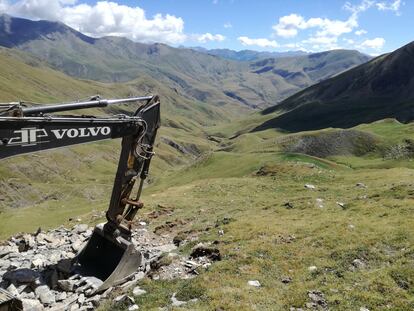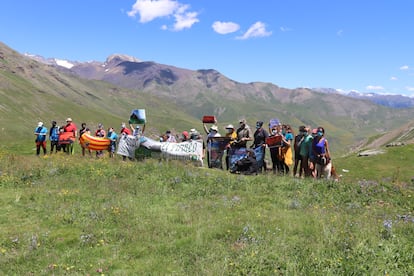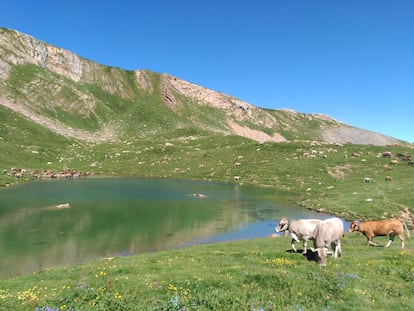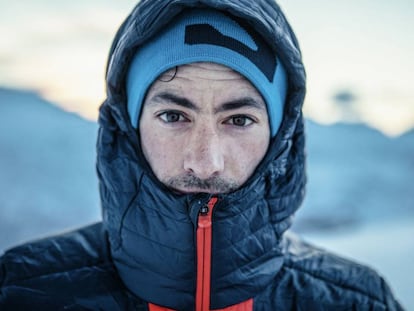The Spanish ski resort turning a blind eye to climate change
Work is underway to extend the slopes in Cerler by 23 kilometers despite the fact that temperatures in the Aragonese Pyrenees are rising faster than the global average


The Cerler ski resort in Spain’s Aragonese Pyrenees is pursuing a controversial plan to extend its ski runs by 23 kilometers toward the virginal Castanesa valley. Work on the expansion began in 2019, and is scheduled to continue this summer.
The original initiative, presented prior to 2008, included the construction of 5,000 houses, but locals in Montanuy, which is situated in Castanesa valley, took legal action and managed to get the urban aspect of the scheme frozen, whereby the entire project was suspended. But now, the company that runs the resort, Aramón, has decided to move forward with expanding Cerler’s ski slopes.
The revival of the project flies in the face of the disproportionate temperature hikes in the Pyrenees in the last 50 years. According to the Pyrenean Observatory of Climate Change (OPCC), temperatures in the Pyrenees are rising far faster than the global average while global warming has reduced the volume of snow, and will probably continue to do so. Residents and environmentalists argue the expansion scheme will destroy a virgin valley and believe that the lack of snow will ultimately make it unworkable. In fact, climate change was the reason put forward in March by the Ministry of Ecological Transition for dismantling three ski slopes in Navacerrada, outside Madrid, a measure that contrasts sharply with what is happening in Cerler.

Jordi Cunillera, from the Meteorological Service of Catalonia, has worked on the OPCC’s Climpy Project that sets out to chart the evolution of the climate in the area. “In the last 60 years, the average temperature on the southern slopes of the Pyrenees has increased by an average of 1.4ºC, and by up to 2ºC in summer,” he says. According to Cunillera, this means snow will decrease in the coming years, especially at altitudes of between 1,500 to 2,000 meters, where ski resorts are usually located. “What was once snow will be rain,” he explains. “The season will become much shorter because the number of days a year that skiing will be possible will continue to be reduced.”
There is already evidence of this trend. “At an altitude of 1,500 meters, the number of days with snow on the ground has dropped from around 80 to 65,” says Cunillera. During the 1960s and 1970s, there were five or six years where there was snow on the ground for more than 100 days at 1,500 meters, but in the last three decades that has dropped to two years. There are also now years with less than 40 days of snow on the ground, something that has not been seen since the period between the 1950s and 1970s.
Aramón explains that the €40-million project will build four access lifts from Cerler to the Castanesa valley, increasing the skiable kilometers in the resort from 77 to 100. This will allow for a wider range of mountain activities beyond skiing, such as ski mountaineering and snowshoeing, according to a company spokesperson. It will also be positive for the promotion of year-round activities in the area, such as hiking and Nordic walking, thereby expanding the tourist season. According to Aramón, which is jointly owned by the Aragón regional government and the Spanish lender Unicaja, the project will provide the Montanuy district with a new tourist attraction that will be fully compatible with livestock farming.
Environmental impact statement
Paco Iturbe, from the Platform in Defense of the Aragón Mountains (PDMA), which brings together locals and ecologists, criticizes Aramón for having “resurrected” the project. “The courts annulled the urban plan for Montanuy,” says Iturbe. “We understood that meant everything was paralyzed. But now they are back at it again.” Iturbe explains that the environmental impact statement, made in 2010, expired in December of last year and a new one needs to be approved. However, the spokesperson for Aramón insists the adapted project has all the necessary administrative and environmental permits.
Locals in Montanuy are divided on the issue. Many of them have already sold their land to Aramón and depend on the ski industry. Xavi Pellicer, 56, is a spokesperson for the association We Want a Future for Castanesa Valley, which supports the project. “I know about skiing and how good it has been for the area and I want the same for my neighbors,” he says. “This extension would enable the valley to be connected, as well as giving it better access to electricity and water.” Pellicer also believes that the investment could help to stem the depopulation of the area.
Meanwhile, Luis de la Infanta, a 60-year-old pensioner who lives in Señu, one of the 17 clusters in the Montanuy district, speaks for those opposed to the expansion. “Since Aramón arrived and bought land from the locals, the valley has become even more depopulated,” he says. “This is a virgin valley, a sort of infinite meadow of green, with a unique beauty created by extensive cattle farming. And that is going to be adversely affected by ski lifts and roads.”
Given the expansion of the Cerler resort was declared a Plan of General Interest of Aragón (PIGA), an expropriation procedure has been initiated and directed at residents reluctant to sell their land. And although most have already sold up, 30 have now taken the matter to court. “How can people be expropriated to facilitate the activity of a private company?” asks Manuel Badía, the spokesperson for these 30 individuals. “If it’s in the general interest, as in a road or a railroad, it is understandable, but that’s not the case. We have filed an administrative lawsuit against the need to occupy these farms and we are going to ask the judge if the need is justified.”

Badía and those he represents have the support of environmental organizations Ecologists in Action and Rural Nature, who also lent their support to the initial case. Aramón refused to comment on the new legal action being taken against them while the mayor of Montanuy, Esther Cereza, did not respond to whether the municipality is preparing a new urban plan to accompany the extension of the slopes. Meanwhile, the Ecological Transition Ministry has not made any official assessment of the project.
Other aspects of the project are also being criticized. For example, ecologist Paco Iturbe says the lack of natural snow will mean a significant amount of artificial snow will be needed. “It takes a lot of water and energy to make snow, which will make the project more expensive,” he says. “This will also drain the aquifers. And chemical components added to the water will affect the terrain.”
Does it make sense to expand Cerler, given this situation? The five largest environmental organizations in Spain – Friends of the Earth, Ecologists in Action, Greenpeace, SEO/BirdLife and the World Wild Fund for Nature – all signed a letter in December stating that the project goes “against the strategies to fight climate change.” According to García from the OPCC, “this type of expansion should take into account our research on climate evolution in the Pyrenees, which should be included in their environmental impact studies. Skiing will be one of the activities most affected by climate change.”
English version by Heather Galloway.
Tu suscripción se está usando en otro dispositivo
¿Quieres añadir otro usuario a tu suscripción?
Si continúas leyendo en este dispositivo, no se podrá leer en el otro.
FlechaTu suscripción se está usando en otro dispositivo y solo puedes acceder a EL PAÍS desde un dispositivo a la vez.
Si quieres compartir tu cuenta, cambia tu suscripción a la modalidad Premium, así podrás añadir otro usuario. Cada uno accederá con su propia cuenta de email, lo que os permitirá personalizar vuestra experiencia en EL PAÍS.
¿Tienes una suscripción de empresa? Accede aquí para contratar más cuentas.
En el caso de no saber quién está usando tu cuenta, te recomendamos cambiar tu contraseña aquí.
Si decides continuar compartiendo tu cuenta, este mensaje se mostrará en tu dispositivo y en el de la otra persona que está usando tu cuenta de forma indefinida, afectando a tu experiencia de lectura. Puedes consultar aquí los términos y condiciones de la suscripción digital.
More information
Últimas noticias
Most viewed
- Reinhard Genzel, Nobel laureate in physics: ‘One-minute videos will never give you the truth’
- Pablo Escobar’s hippos: A serious environmental problem, 40 years on
- Charles Dubouloz, mountaineering star, retires at 36 with a farewell tour inspired by Walter Bonatti
- Why we lost the habit of sleeping in two segments and how that changed our sense of time
- The fall of a prolific science journal exposes the billion-dollar profits of scientific publishing










































